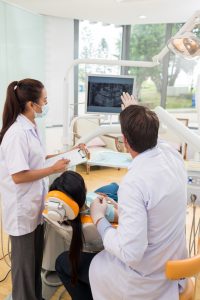 Traditional x-ray technology was first documented as early as the 1890s and has been used in dentistry for decades since. If fact, many dental practices today still use this form of imaging to locate hard tissue concerns in the teeth and jawbone undetectable to the naked eye. Around 1990, digital x-ray technology was introduced into the dental industry as a safer and more effective method for detecting tooth decay and jawbone abnormalities. With this technology, once the images are taken, they are immediately uploaded to a nearby computer where the dentist can zoom in and manipulate the images for a clearer picture and more accurate diagnosis.
Traditional x-ray technology was first documented as early as the 1890s and has been used in dentistry for decades since. If fact, many dental practices today still use this form of imaging to locate hard tissue concerns in the teeth and jawbone undetectable to the naked eye. Around 1990, digital x-ray technology was introduced into the dental industry as a safer and more effective method for detecting tooth decay and jawbone abnormalities. With this technology, once the images are taken, they are immediately uploaded to a nearby computer where the dentist can zoom in and manipulate the images for a clearer picture and more accurate diagnosis.
In the early 2000s, cone beam computed technology made its introduction into the industry and has been radically changing the way dentists diagnose and treat patients for over the past decade. More and more dentists each year are making this technology available in-office to deliver convenient treatment planning for their patients.
What is Cone Beam Scanning?
Cone beam computed technology (CBCT), also known as cone beam scanning, is a specialized form of x-ray technology that can capture 3-D images of your teeth, gums, surrounding soft tissues, nerve pathways, and jawbone. Once the images are captured, they are immediately uploaded to a computer where specialized software creates a three-dimensional model of your teeth, gums, and jawbone. This technology has revolutionized the way dentists are able to diagnose and treat hard tissue disorders, especially when planning dental implant procedures.
How Cone Beam Scanning Works
Before the scan takes place, you will be asked to remove jewelry, removable dental devices, eyeglasses, hearing aids, and any metal objects that could interfere with the technology. As with any x-ray examination, it’s important to alert the technician beforehand if you are pregnant.
The cone beam scanning system consists of a digital x-ray scanner mounted on a rotating arm that captures images of every angle of your face within a matter of seconds. This technology gets its name from the way it projects x-rays in in a cone-shaped beam. The technician will have you sit in a chair and bite down on a special tool to hold your mouth in proper position while the scanner arm rotates around your head and takes a large number of images. The entire process takes about 20 seconds and pro. Once the images are captured, the doctor can view your teeth and jawbone at different angles. A 3-D model of your mouth is then created for easy diagnosis and treatment planning.
Common Ways it’s Used in Dentistry
Below are different ways dentists are able to use cone beam technology in dental treatments:
- Diagnosing TMJ disorder
- Planning dental implant surgery, ensuring accurate placement
- Examining the jawbone, sinuses, and nasal cavities for abnormalities
- Evaluating the nerve pathways for origins of pain
- Planning surgery for impacted teeth
- Planning orthodontic treatment
Benefits of Cone Beam Scanning
Cone beam scanning provides many benefits for both the patient and doctor, including:
- Provides less radiation exposure than traditional x-ray technology
- Produces better image quality than both traditional and digital x-ray technology
- Allows the doctor to deliver more accurate diagnosis and treatment planning
- More comfortable and noninvasive alternative to capturing x-rays
- Provides immediate results and faster diagnosis
- Provides surgical guide for precise dental implant placement
Contact Us to Learn More
At Fresno Dental Scan, Drs. Alex and Claudia Denes will use a cone beam scanner to carefully plan your dental implant procedure to ensure you achieve a successful outcome. If you are interested in learning more about cone beam scanning and how you can benefit from this technology, contact our Fresno, CA office online or by calling (559) 297-6823.